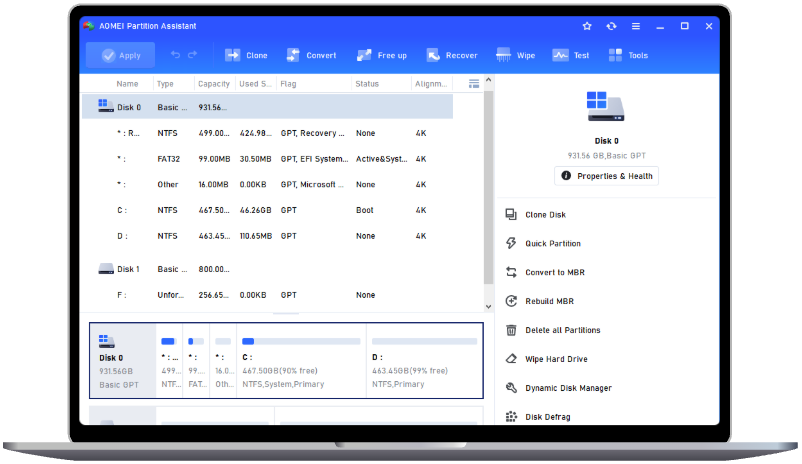How Long to Copy 4TB of Data? Speed Up the Process Now
Wondering how long to copy 4TB of data? This article breaks down the key factors that affect transfer time, including drive types, connection interfaces, and system performance. It also introduces several effective methods to help you transfer data more efficiently.
How Long to Copy 4TB of Data?
Hi, I’m planning to tcopy 4TB of data from an old HDD to a new SSD using a USB 3.0 connection. How long should this take? Are there ways to speed up the process?
- Question from User
Copying large amounts of data isn’t as simple as dragging and dropping files. In most cases, it involves transferring an entire partition or even a full disk to a new location. The time it takes to copy this data depends on several key factors, including:
1. Type of Storage Device
The type of storage device used plays a significant role in the speed of data transfer. HDDs (hard disk drives) are slower than SSDs (solid-state drives). This is because HDDs rely on mechanical parts that have physical moving components, while SSDs use flash memory to store data, which is much faster.
👉 HDD to HDD Transfer: Copying data between two hard drives is usually slower, especially if the source drive is old or fragmented.
👉 SSD to SSD Transfer: SSDs are much faster for data transfer. NVMe SSDs are even quicker than SATA SSDs, which helps speed up the process.
2. Connection Interface
The speed of your data transfer is also affected by the connection interface used between the devices.
👉 USB 2.0: Offers speeds of 480 Mbps, making it a poor choice for transferring large data volumes like 4TB.
👉 USB 3.0/3.1: Offers much faster speeds (5 Gbps to 10 Gbps), which can significantly reduce the time it takes to copy large amounts of data.
👉 Thunderbolt: One of the fastest connection interfaces. Thunderbolt 3 can transfer data at speeds of up to 40 Gbps, making it the best choice for fast data transfer.
👉 SATA and NVMe: For internal drives, SATA can transfer data at speeds up to 6 Gbps. NVMe is much faster, with speeds up to 32 Gbps. This makes the copying process much quicker.
3. File Size and Number
Another key factor in determining how long the data transfer process typically takes is the file size and number. If you're copying many small files, it will take longer than copying a few large files. This is because the system needs more time to handle each file one by one. For instance, copying 4TB of data takes longer than copying 1TB of data.
4. System Performance
Your computer’s performance affects how fast the data can be copied. A faster CPU and enough RAM can help speed up the process. This is especially true when copying between drives or doing other tasks at the same time. The condition of the drives also matters. Additionally, the condition of the drives can also influence performance. For example, older or fragmented drives take longer to copy 4TB of data because of their slower read/write speeds.
A High-Speed Way to Copy Large Amounts of Data
Now that you understand the factors that affect data transfer speed, let’s look at a faster and more efficient solution. One of the quickest ways to copy large amounts of data (eg, 4TB) is by cloning the entire disk or partition using a reliable disk cloning tool. Unlike traditional copy-and-paste methods, cloning creates a complete, sector-by-sector copy of your drive, including all system files, installed programs, and user data.
AOMEI Partition Assistant is a powerful and user-friendly tool that makes this process simple and safe. With just a few clicks, you can clone your entire disk/partition, or migrage only the OS to another drive without manually selecting or moving files one by one.
Why Copy Large Amounts of Data by Cloning?
✔️ No manual file selection required: Save time by avoiding the need to choose files and folders individually.
✔️ Creates an exact copy: Everything on the original drive—including the operating system, installed applications, and all personal files—is duplicated.
✔️ Data safety and integrity: Prevent the risk of missing, corrupted, or misplaced files during transfer.
✔️ Bootable system migration: If you're switching to a new drive, cloning ensures your system remains bootable without requiring reinstallation.
Let’s use AOMEI Partition Assistant to copy 4TB of data:
Step 1: Launch AOMEI Partition Assistant, click "Clone" on the main interface, and select "Clone Disk."
Step 2: Choose the drive that you want to clone as the source disk and click "Next."
Step 3: Select the destination disk where you want to store the data, then click "Next." The destination drive space should be equal to or larger than the used space on the original drive.
Step 4: In the next window, review the source and destination drives. You can choose to enable “Sector to Sector clone” for a more thorough transfer, then click "Confirm" to proceed.
Here, you can also click the "Settings" button to adjust the partition size on the destination disk or tick "4k alignment" to improve the reading and writing speed of SSD if the target disk is an SSD drive.
Step 5: Click "Apply" and then "Proceed" in the main interface to start the cloning process.
FAQs
Q1: How long to copy 4TB of data with USB 3.0?
Using USB 3.0, copying 4TB of data could take anywhere from 8 to 12 hours, depending on the speed of the drives and the type of files being transferred.
Q2: Why is my data transfer so slow?
Slow data transfer can be caused by:
- Old or fragmented drives
- USB 2.0 or outdated ports
- Low RAM or slow CPU
- Transferring many small files instead of fewer large ones
Q3: Is disk cloning faster than manual file copying?
Yes, disk cloning is generally faster than manually copying files because it copies the entire disk as one operation, rather than handling individual files.
Conclusion
In conclusion, how long to copy 4TB of data depends on several factors, including the type of storage device, the connection interface, and the system’s performance. While copying large amounts of data may seem daunting, using efficient methods like disk cloning with AOMEI Partition Assistant can significantly speed up the process. By understanding the key factors that affect transfer times and utilizing the right tools, you can ensure faster and smoother data transfers.


